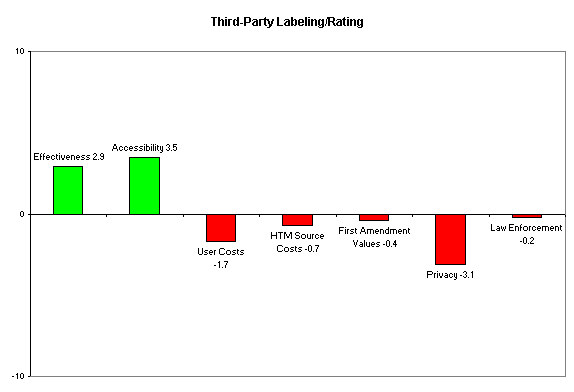|
C. Labeling and Rating Systems
6. First-party labeling/rating
Voluntary action by content sources to indicate that a site or particular content meets a particular standard or fits a particular category. The "label" can take the form of a metatag, or entry into a database listing, or display of a seal. The use of a label may be audited. For purposes of considering this technology, the Commission will assume that the voluntary labeling scheme would identify material that is harmful to minors and thereby allow others to filter or block such material.

Commentary
- Although potentially effective if widely used, this method has not been adopted by many Web publishers.
- The effectiveness of voluntary first-party labeling is limited because it is dependent in part on widespread adoption.
- This is a low cost method for consumers and other end-users; browsers that look for self-labels do so at no cost.
- This method may impose costs on all sources of harmful to minors material, depending on the complexity of the labeling or rating design and on requirement to label or rate each web page.
- This method raises First Amendment concerns due to the financial cost to constitutionally protected sites, blocking of unlabelled sites, and the threat that voluntary labeling regimes might be made mandatory.
- This method may facilitate creation of lists of child-appropriate sites and greenspaces.
7. Third-party labeling/rating
Voluntary action by third parties to review content sources and to associate labels or ratings with such sources so as to enable filtering or blocking by others. The review may involve some automated parsing and some human judgment. For purposes of considering this technology, the Commission will assume that the labeling and related filtering may involve various "categories" established by private parties and that no affirmative action is required by a content source.

Commentary
- This approach is similar to that followed in the motion picture industry, where a third party assigns a rating to each film. It is not widely used on the Internet at this time. It requires that third parties engage in rating a large number of sites.
- Third-party labeling/rating could be effective if third parties, such as advocacy groups, were to decide to engage in this process, or if the adult-content industry were to cooperate in establishing a third-party labeling regime. Any such scheme will be challenged by the immense scope of the content to be rated and constant changes in web site content.
- This technology has the potential for coordination with rating schemes in other media. At this time, however, there is no clear business model for this approach on the Internet.
- First Amendment concerns derive from the fact that labels assigned to content by third parties will reflect cultural or social standards that may not be shared by others.
- Third party labeling would have little or no adverse impact on privacy or on law enforcement.
|
